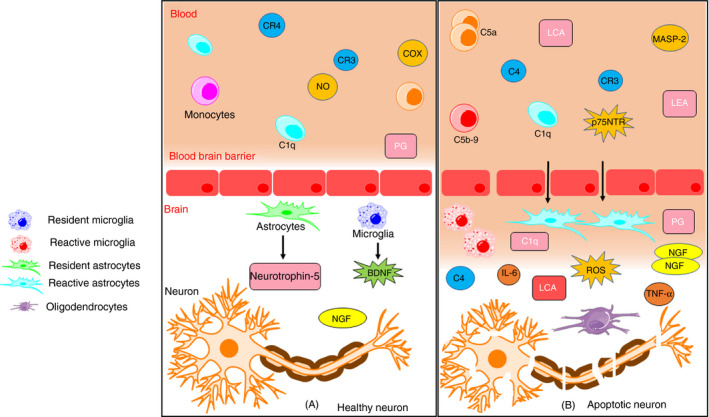FIGURE 4.

Neuroinflammation in ALS. (A) Components of the complement system, microglia and astrocytes reside near the blood‐brain barrier and help in homeostasis and protection of CNS. It promotes neurogenesis by releasing BDNF, neurotrophin‐5, etc. It also helps in removing debris and suppressing inflammation and therefore leads to neuroprotection. (B) On tissue injury, activation of C4a, C5a and C3 of the complement system is responsible for the entry of microglia and astrocytes to promote its conversion from resting to its activated form. Reactive microglia and astrocytes release pro‐inflammatory markers such as TNF‐α, IL‐1β and iNOS. These markers further lead to the generation of ROS and culminate in oxidative stress. In addition to this, reactive microglia causes upregulation of LFA‐1, LCA, complement receptor CR3 and CR4, immunoglobulin receptor FcγR1 and MHC‐II complex. Chronic activation of C3a and C5a promotes entry of peripheral immune cells, which secretes chemokines and cytokines on endothelial cells and disrupts the integrity of BBB. It also causes induction of NGF correlated with p75NTR in an area of degenerating motor neurons, which leads to apoptosis (BDNF – brain‐derived neurotrophic factor, TNF‐α – tumour necrosis factor, IL – interleukin, iNOS – inducible nitric oxide synthase, ROS – reactive oxygen species, LFA‐1 – lymphocyte function‐associated molecule‐1, LCA – leucocyte common antigen, NGF – nerve growth factor, p75NTR‐p75 – neurotrophin factor, FcγR1 – fragment crystallizable gamma receptor 1, BBB – blood‐brain barrier, MHC – major histocompatibility complex) (Adapted from Servier Medical Art by Servier, licensed under a Creative Commons Attribution 3.0 Unported Licence (http://smart.servier.com/))
